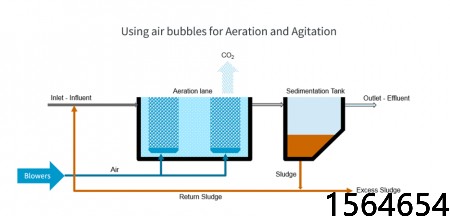Related News
- Roots Blowers: Powering Efficient and Sustainable Aquaculture2025-06-25
- Roots Blowers: Essential for Modern Aquaculture2025-06-25
- The Important of Roots Blower in Aquaculture2025-06-25
- The Role of Tri-Lobe Roots Blowers in Wastewater Treatment2025-06-25
- Roots blower for wastewater treatment aeration2025-06-25
- Applications of Three-Leaf Roots Blowers in the Paper and Pulp Industry2025-06-25
Wastewater Treatment: Design Consideration for Blowers
Blowers are primarily utilized in the secondary phase of treatment to generate air bubbles, which facilitate two primary processes: aeration and agitation.
Wastewater treatment is essential across various industries, from food and beverage to textiles. It equips users with the means to mitigate damage to one of our most valued natural resources. Water, being a crucial element, provides an effective conduit for waste products in both municipal and industrial settings, thanks to its unique properties.
The objective of wastewater treatment is to augment natural processes and restore water to a desired level of purity. In municipal contexts, treated wastewater is discharged back into natural waterways. For industrial applications, after treatment, water can be repurposed within the facility, fed into a municipal wastewater system for additional processing, or released into natural water bodies.
The treatment of wastewater typically involves two fundamental stages: primary and secondary. The primary stage functions as a clarifier, allowing wastewater to separate, with greases and oils rising to the top and solids settling at the bottom. Subsequently, water proceeds to an aeration tank to commence the secondary phase. This stage employs biological processes to further purify the wastewater. In some cases, a tertiary phase is implemented, involving additional chemical treatment.

IMAGE 1: Using air bubbles for aeration and agitation
During the first reaction, oxygen (O2) combines with nitrogen to produce carbon dioxide (CO2), ammonia, and the energy required for the proliferation of microorganisms. In a subsequent reaction, ammonia, microorganisms, and oxygen (O2) are converted into nitrous oxide, water, and additional microorganisms.
By taking samples and applying an engineering calculation based on biological oxygen demand, ammonia levels, and oxygen transfer efficiency, the standard cubic feet per minute (SCFM) requirement for the system can be determined.
When considering SCFM, remember that it is a mass flow rate, which will change with variations in ambient temperature and pressure. For instance, hot air contains less oxygen per cubic foot than cooler air. This implies that to calculate actual flow rates for the product and application, these calculations should at least take into account the site’s elevation, as well as the highest and lowest ambient temperatures.
A second factor to consider in blower sizing is the anticipated system pressure. If a blower has a rating of 17 pounds per square inch (psi), this indicates the maximum system backpressure the blower can overcome. This capability is a function of the blower’s motor power; generally, the more powerful the motor, the higher the pressure that can be introduced into the pipe.
FUN FACT: A blower does not actually create system pressure. Unlike a compressor, which does generate system pressure, blowers produce flow. The pressure arises from the backpressure in the system, which is influenced by the static pressure related to tank depth, as well as pressure losses or friction from piping or diffuser pads.
Another significant factor is turndown. Since nothing in wastewater treatment is typically in a steady state, relying on a single fixed-speed blower to provide a constant airflow will not efficiently serve a wastewater treatment facility. There are peaks and troughs in the influx, and an efficiently designed system should be able to adjust to these changes.
Energy cost consistently represents the largest portion of the overall cost of ownership for blowers in wastewater treatment. To achieve energy savings, the blower should adjust its flow to meet demand. It is not unusual to see a ratio of maximum to minimum flow of 10:1 or higher in a wastewater treatment facility.
Wastewater treatment facilities often use dissolved oxygen sensors in their tanks to monitor oxygen levels, which then feed back into a control system. This system adjusts the flow from the blowers to maintain the desired range for bacterial growth.
Redundancy is Essential
Aeration levels in wastewater treatment are typically five to seven times higher than naturally occurring levels. If the oxygen level were to suddenly drop, microorganisms would begin to perish rapidly. Wastewater treatment systems can take days or weeks to rebalance, so system operators cannot afford this risk. Consequently, wastewater treatment systems usually incorporate multiple blowers to ensure redundancy, allowing the process to continue uninterrupted even if one blower requires maintenance or repair.
Operators often split systems into multiple machines. For example, a three-plus-one system would consist of three units capable of handling 1/3 of the maximum flow, plus an additional standby unit. This setup enables operators to adjust the flow to optimize system efficiency, resulting in energy savings and maintaining redundancy through a backup machine. Such systems often require a smaller investment than a single machine capable of handling 100% of the flow plus a backup unit.
Additionally, operators frequently employ load balancing, where either a controller or a manual approach is used to alternate the machines’ roles between primary, secondary, and redundancy. Over time, this ensures that all machines accumulate the same amount of run hours, aiding in maintenance and extending the life cycle.
Determining the equipment needs for wastewater treatment applications can involve numerous variables, and selecting the appropriate setup can greatly impact system efficiency and effectiveness.
Search Starts Here
